Her Majesty's Prison Service
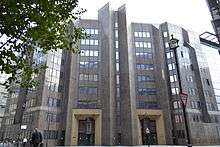
Her Majesty's Prison Service is a part of Her Majesty's Prison and Probation Service (formerly the National Offender Management Service), which is the part of Her Majesty's Government charged with managing most of the prisons within England and Wales. (Scotland and Northern Ireland have their own prison services: the Scottish Prison Service and the Northern Ireland Prison Service, respectively.)
The CEO of HMPPS, currently Michael Spurr, is the administrator of the prison service. The CEO reports to the Secretary of State for Justice and also works closely with the Prisons Minister, a junior ministerial post within the Ministry of Justice.
It has its head office in Clive House in London,[1] and previously its head office was in Cleland House in the City of Westminster, London.[2]
The British Overseas Territory of Bermuda's HM Prison Service (renamed the Department of Corrections in 2002) was a separate organization.
Operation
In 2004, the Prison Service was responsible for 130 prisons and employed around 44,000 staff. As of 2009 the number of prisons had increased to 131, including 11 privately owned prisons.[3]
The Service's statement of purpose states "Her Majesty's Prison Service serves the public by keeping in custody those committed by the courts. Our duty is to look after them with humanity and help them lead law-abiding and useful lives in custody and after release." The Ministry of Justice's objective for prisons seeks "Effective execution of the sentences of the courts so as to reduce re-offending and protect the public".
Population statistics for the Service are published weekly. Statistics available for 24 June 2016 showed the service housed 85,130 prisoners: 81,274 males and 3,856 females.[4]
Reform
Early in 2004, it was announced that the Prison Service would be integrated into a new National Offender Management Service later in the year.
As of 2008, rationalisation of the prison management system is underway with the advent of the Titan Prison concept.
Six new reform prisons are to be built with prison governors in charge of operation and budget. Penal charities claimed reforms would fail if prisoners were "crammed into filthy institutions with no staff".[5]
In 2017 the National Offender Management Service (NOMS) became Her Majesty's Prison and Probation Service (HMPPS).
Current issues
The imprisonment rate for England and Wales is the highest in western Europe,[6] and at roughly the "midpoint" worldwide.[7] The prison population currently numbers 83,165 in August 2018. The Ministry of Justice currently projects that this will rise to 86,400 by March 2023.[8]
Despite a fall in crime rates between 2010 and 2016, the prison population continued to rise, while staff numbers were reduced,[9] with the number of prison officers being reduced from 25,000 in 2010 to about 18,000 in 2015.[10] There has been a particularly sharp rise in the number of prisoners above the age of 60.[11]
In 2017, two-thirds of prisons were found to be unsatisfactory in at least one respect. Problems include overcrowding, prisoners committing assaults and self-harm and the smuggling of mobile phones and illegal drugs into prisons.[12] Following a significant rise in prison disorder in 2015 and 2016,[13] in November 2016 Justice Secretary Elizabeth Truss announced a £1.3 billion investment programme in the prison service and the recruitment of 2,500 additional prison officers, partly reversing the cuts made under the previous coalition government.[10][14] A number of prison riots in late 2016 (including at Bedford, Lewes, Birmingham and Swaleside prisons)[15] drew further media attention to the issue. Andrea Albutt of the Prison Governors Association said prison riots caused "grave concern" and further governors faced "unacceptable stress and anxiety". The PGA maintains there are 40 prisons of concern and 10 of them are very concerning.[16]
The Justice Select Committee[17][18] and agencies such as the National Council of Independent Monitoring Boards, the Prison Governors Association,[16] Prison Officers' Association[19] and Council of Europe[20] have attributed the rise of disorder in prisons to understaffing and budget cuts. Other factors include the increased availability of synthetic cannabinoids[21] and drones for smuggling. The PGA also suggested that the recruitment of "unsuitable people" as prison officers and poor training were other factors. Albutt suggested that prison sentences of less than a year should be replaced with alternative punishments.[16]
Another issue is the age of several prisons. A 2015 announcement from the government agreed that old prisons are more expensive to run and often unsuitable in design, such as having "dark corners which too often facilitate violence and drug-taking."[22]
Prison officers
Recent development
Historically, uniformed prison staff were under the supervision of a small number of very senior and experienced officers who held one of three Chief Officer ranks; however, reorganisation in the 1980s termed "A Fresh Start" saw these Chief Officer ranks abolished, and their role taken by junior grade prison Governors.
From 2000 onwards, as part of a process to increase accountability within the prison service, all operational officers have been assigned a 3-digit unique identification number, worn on all items of uniform (typically as an embroidered epaulette) along with the 2-digit LIDS identification code of the specific prison or institution. From 2010 onwards, attempts were made to replace the Principal Officer rank with non-uniformed junior managers (Developing Prison Service Managers - DPSM), although this process was neither entirely successful nor fully implemented.
Further restructuring in 2013 named 'Fair & Sustainable' saw the remaining historic ranks and rank insignia phased out in favour of a new structure, and simple stripes on uniform epaulettes to indicate grades.
Powers and structure
Public sector prison officers (historically known as warders) have "all the powers, authority, protection and privileges of a constable" whilst acting as such.[23]
Although the system is flexible in operation, most Prison Officers work in small teams, either assigned to a specific duty, or providing one shift of staff for the supervision of a particular wing within a prison. Each such team is led by a Supervising Officer (not all prisons). There will be an overall manager of the wing with the title of Custodial Manager. Custodial Managers (CM) will have direct management of the wing and the line management of the Officers and Supervising Officers (SO).
| Historic rank insignia in use until 1987 | ||||||
|---|---|---|---|---|---|---|
| Rank | Prison Officer | Senior Prison Officer | Principal Prison Officer | Assistant Chief Officer | Chief Officer (Grade II) |
Chief Officer (Grade I) |
| Insignia |  |
 |
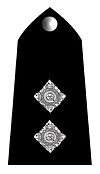 |
 |
 |
 |
| Rank insignia from the "A Fresh Start" initiative, 1987–2000 | ||||||
| Rank | Prison Officer | Senior Officer | Principal Officer | |||
| Insignia |  |
 |
 |
The Chief Officer grades were abolished and replaced with junior Governor grades. | ||
| Revised rank insignia with LIDS code and unique identification numbers, 2000–2013 | ||||||
| Rank | Operational Support Grade (OSG) | Prison Officer | Senior Officer | Principal Officer | (Specialist Officer) | |
| Insignia |  |  |  | 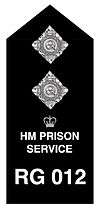 |
Additionally authorised letters could be used to indicate specialist functions: DH - dog handler W - works officer H - healthcare officer | |
| Current rank insignia introduced from April 2013 | ||||||
| Rank | Operational Support Grade (OSG) | Prison Officer | Supervising Officer | Custodial Manager | (Specialist Officer) | |
| Insignia | 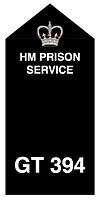 |  | 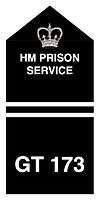 |  |
Specialist Officers have role identification letters on their epaulettes: DH - dog handler W - works officer H - healthcare officer | |
Specialist roles
In addition to uniformed officers carrying out security and custodial roles, a number of specialist functions exist within every prison. Some are assigned to uniformed Specialist Officers, whilst others are carried out by non-uniformed support staff.
Before the "Fresh Start" initiative of the mid-1980s there were more uniformed specialist officer roles, including dog handlers, works officers, hospital officers, catering officers, physical education officers, and officer instructors. Today the uniformed Specialist Officer roles include dog handlers (DH), works officers (W), and healthcare officers (H) who are the successors of the former hospital officers. The roles of the former catering officers, PE officers, and officer instructors are today taken by non-uniformed caterers, PE instructors, and educational/vocational instructors.[24]
Other key non-uniformed roles within the staff of a prison include chaplains, psychologists, and administrators.[24]
Private prisons
The Prison Service does not manage all prisons within England and Wales. Currently there are eleven prisons that have been designed, constructed, managed and financed (so-called DCMF prisons) privately. In addition, three prisons that were built with public money are managed by private companies under contract. During 2012 one further prison opened under private sector management: HMP Oakwood (Featherstone 2), built by the public sector. Private prisons are subject to scrutiny by Her Majesty's Chief Inspector of Prisons in a similar manner to prisons run by the public Prison Service.
Ban on industrial action
Questions were raised about the POA's status in the 1990s. In 1994, a legal decision determined that it was illegal to induce prison officers to take industrial action - a law which had applied to police officers since 1919 - meaning that the POA could not call strike action amongst its members. New labour legislation introduced by the Conservative government in 1992 laid down that the POA could no longer be a trade union. This was reversed in the Criminal Justice and Public Order Act of 1994, but prison officers were still denied the right to take industrial action. This right was restored in 2004 to prison officers in the public sector in England, Wales and Scotland, but not in Northern Ireland or to prison custody officers in the private sector.
On 29 August 2007, the POA started a 24-hour walkout of prisons, picketing establishments asking prison officers not to attend work for their shift. This was the first ever national strike action taken by the POA. The POA reported that 90% of its members (27,000) went on strike that day.
In January 2008, the Home Secretary announced that the government was to introduce legislation to remove the right for Prison Officers in England and Wales to take strike action.[25] In November 2016, the High Court approved a Government request to stop industrial action taking place.[26] In July 2017 the Government won a High Court bid to obtain a permanent ban on industrial action by prison officers.[27]
Independent Monitoring Board
Every prison and immigration removal centre has an Independent Monitoring Board (IMB), formerly known as a Board of Visitors. Members of the IMB, who are volunteers, are appointed by the Home Secretary and act as 'watchdogs' for both the Minister of Prisons and the general public, to ensure that proper standards of care and decency are maintained.[28] An analysis of the reporting of IMBs found that while there may be some problems with their training and undertaking of duties, their monitoring and surveillance of the detention estate can be more than symbolic and may further the humane and just treatment of the state’s most vulnerable citizens.[29]
HMPS in the National Offender Management Service
On 6 January 2004, then Home Secretary David Blunkett announced that the Prison Service, together with the National Probation Service, is to be integrated into a new National Offender Management Service. The Service, Blunkett said, will be "a new body to provide end-to-end management of all offenders".
On 1 April 2008, NOMS was reorganised as part of a shake-up in the Ministry of Justice. The headquarters and regional structures of NOMS and HMPS were merged into a single HQ structure with Phil Wheatly as Director General of NOMS. This brings HMPS and the National Probation Service under a single headquarters structure for the first time ever.[30]
On 1 June 2011, NOMS was merged with the wider MoJ (HMCTS etc.) to form one organisation. Although HMCTS and NOMS are working under different terms and conditions, they are now managed together and HR is dealt with by one Shared Service centre. A review of terms and conditions for all MoJ staff, including NOMS, is currently in progress with view to bringing all staff terms and conditions across NOMS and HMCTS in line.
See also
Her Majesty's prison service collection is held at the Galleries of Justice Museum in Nottingham.
References
- ↑ "Home". Her Majesty's Prison Service. Retrieved 2018-04-27.
HM Prison Service Clive House 70 Petty France
- ↑ "Contact us". HM Prison Service. Archived from the original on 17 June 2009. Retrieved 13 February 2010.
HM Prison Service Headquarters Cleland House Page Street London, SW1P 4LN.
- ↑ "Performance ratings". Government of the United Kingdom. Archived from the original on 26 July 2009.
- ↑ "Prison population figures: 2016". Government of the United Kingdom. Retrieved 30 June 2016.
- ↑ "Pilot in prisons seeks to cut violence". BBC. 8 February 2016.
- ↑ England and Wales have highest imprisonment rate in western Europe The Guardian
- ↑ "Prison population". BBC. Retrieved 14 August 2018.
- ↑ Prison population set to rise despite overcrowding crisis The Guardian
- ↑ Surge in jail population adds to strain on overstretched prison service The Guardian
- 1 2 "Prisons to get 'biggest overhaul in a generation'". BBC News. 3 November 2016. Retrieved 17 November 2016.
- ↑ Doward, Jamie. "Rolf Harris leaves behind gilded lifestyle for vulnerable prison unit". The Guardian. Retrieved 10 November 2015.
- ↑ Exclusive: shock figures reveal state of UK’s brutal prisons The Observer
- ↑ Alan Travis (27 October 2016). "Prison violence epidemic partly due to staff cuts, MoJ admits". The Guardian. Retrieved 17 November 2016.
- ↑ Alan Travis (3 November 2016). "Prisons in England and Wales to get 2,500 extra staff to tackle violence". The Guardian. Retrieved 17 November 2016.
- ↑ Birmingham, Bedford and Lewes prison riots followed 'low staffing warnings' BBC
- 1 2 3 Release short-term inmates from 'bursting' jails, say governors BBC
- ↑ Alan Travis (18 March 2015). "UK justice minister 'complacent' over 38% rise in prison deaths, say MPs". The Guardian. Retrieved 17 November 2016.
- ↑ "Prisons: planning and policies" (PDF). House of Commons Justice Committee. UK Parliament. 18 March 2015. HC 309. Retrieved 17 November 2016.
- ↑ Authorities quell trouble at Hertfordshire and Wiltshire prisons The Guardian
- ↑ £40,000 worth of drugs discovered at 'unsafe' Lancashire prison The Guardian
- ↑ "Prison nurses are ending up in hospital because of levels of 'Spice' fumes". 14 May 2018. Retrieved 11 September 2018.
- ↑ "Prison building revolution announced by Chancellor and Justice Secretary". Government of the United Kingdom.
- ↑ "Prison Act 1952 (Section 8)". Government of the United Kingdom. 2015. Retrieved 10 November 2015.
- 1 2 "Working for HMPS". UK Government. Retrieved 31 December 2015.
- ↑ "Ministers seek prison strike ban". BBC News. 7 January 2008. Retrieved 10 November 2015.
- ↑ "High court orders prison officers to end protest and go back to work". The Guardian. 15 November 2016. Retrieved 24 November 2016.
- ↑ "Government wins High Court bid to ban prison officer strikes". Sky UK.
- ↑ "Independent Monitoring Boards". imb.org.uk. 2015. Retrieved 10 November 2015.
- ↑ Roffee, James A. (2017-02-01). "Accountability and Oversight of State Functions". SAGE Open. 7 (1). doi:10.1177/2158244017690792.
- ↑ "National Offender Management Service". Government of the United Kingdom. Retrieved 10 November 2015.
External links
- HM Prison Service—Ministry of Justice
- Official website (Archive)
- Press release from Home Office about re-organisation
- Prison Officer blog
- Prison Officer learning program
.svg.png)